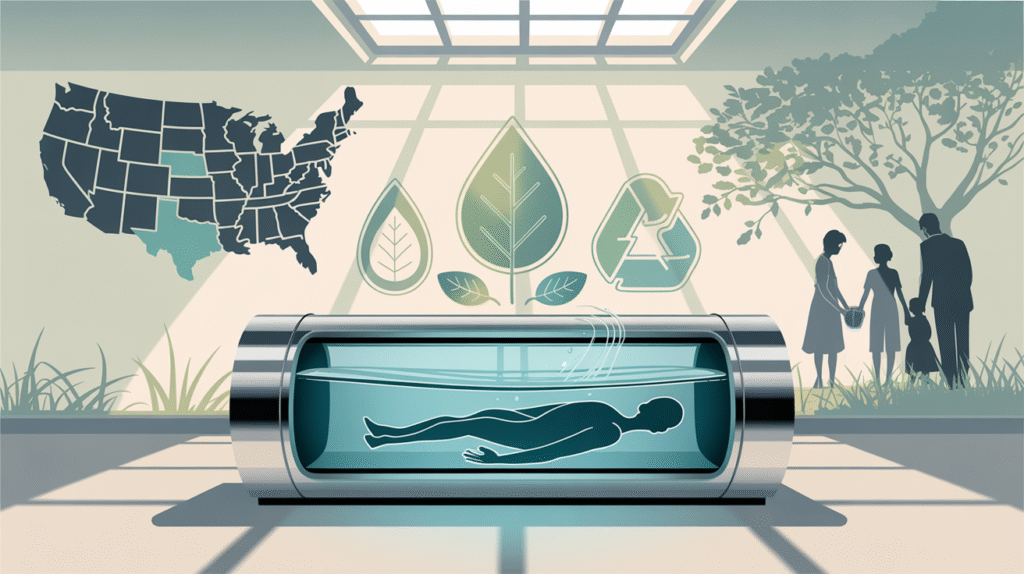
If you’ve heard the buzz about “water cremation” but still aren’t sure how it works—or whether you can even choose it where you live—this deep-dive is for you.
1. What exactly is aquamation?
Aquamation (technical name alkaline hydrolysis) places the body in a stainless-steel pressure vessel filled with 95 % warm water and 5 % alkaline solution (potassium or sodium hydroxide). In about six hours, gentle heat and water break down soft tissue, leaving two things:
- a sterile liquid rich in nutrients
- the skeletal framework, which is dried and processed into ash—just like flame cremation
Because the process happens at roughly 200 °F (versus 1,600 °F for flame cremation) and relies on electricity, it uses about 90 % less energy and produces a tenth of the carbon footprint.
| Top Motivator | What Families Say |
|---|---|
| Environmental impact | “No fossil-fuel flames; no mercury or greenhouse gases.” |
| Gentler image | The nickname “the gentle goodbye” resonates with people uneasy about fire. |
| Bone ash quality | Up to 20 % more remains are returned, and they’re brighter white, which many find comforting. |
| Cost parity | Prices are now similar to—or slightly below—traditional flame cremation in most pilot facilities. |
3. Where is aquamation legal today?
As of May 2025, 28 states have statutes or regulatory rulings that allow aquamation for human remains. Minnesota was first (2003); the newest additions are Hawaii (2022) and Oklahoma (2021). Earth FuneralUS Funerals Online
Quick check: If you live in Alabama, Arizona, California, Colorado, Connecticut, Florida, Georgia, Hawaii, Idaho, Illinois, Kansas, Maine, Maryland, Michigan, Minnesota, Missouri, Nevada, North Carolina, North Dakota, Oklahoma, Oregon, Tennessee, Utah, Vermont, Washington, West Virginia, Wyoming—or you’re willing to transport remains to one of those states—you can legally choose aquamation today.
Six more states (including Virginia and New York) have active bills in 2025, so the map is likely to grow again this year.
4. How does it compare on emissions and energy?
Researchers estimate that flame cremation releases roughly 534 lbs. of CO₂ per body (much of it from the natural gas that powers the retort). Aquamation’s electric heat and sealed chamber cut that figure to ~54 lbs., and any electricity can be offset with renewables.
| Concern | Reality |
|---|---|
| “The body is poured down the drain.” | The liquid that remains is sterile—no DNA, no pathogens—and is safely returned to the municipal system under guidelines similar to hospital waste-water. |
| “Religions forbid it.” | The Catholic Church officially opposes aquamation, but most Protestant, Jewish, Buddhist and secular groups have issued no prohibitions. |
| “It’s not available near me.” | True in many places: legislation is outpacing infrastructure. Only about 40 human-grade systems operate nationwide today. However, demand is driving new installations, especially in eco-conscious metro areas. |
6. What does it cost?
- Average U.S. price (2025): $1,995 – $3,200
- What’s included: container, aquamation cycle, processing of remains, temporary urn
- Extras to budget: transport if your county lacks a facility, death certificates, and any ceremony you choose to hold separately
Prices mirror direct flame cremation in many markets and can run 20-30 % less than burial once cemetery fees are factored in.
The takeaway
Aquamation isn’t futuristic—it’s happening quietly in nearly half the country, driven by families who want a kinder environmental footprint without sacrificing the familiar ritual of receiving an urn of ashes. With more state legislatures—and consumers—on board each year, water-based cremation is poised to become a mainstream option sooner than many funeral directors expected.
Give Their Story the Art It Deserves
When a life is extraordinary, a mass-produced metal box just feels wrong.
Pulvis Art Urns turns remembrance into art—each ceramic urn is hand-thrown and sculpted in Europe, kiln-fired to museum-grade quality, and certified to ISO standards for lasting strength. The result? A one-of-a-kind memorial that looks at home on a mantel, garden niche, or gallery shelf. From modern abstract forms to classic pottery-wheel silhouettes, every piece whispers craftsmanship and quiet grace—so family and guests see a tribute, not a container. Explore the collection today and discover why Pulvis is the global leader in high-end memorial design. (Pulvis Art Urns)
